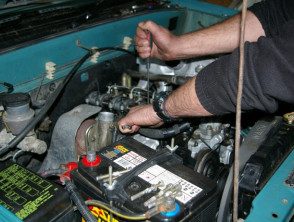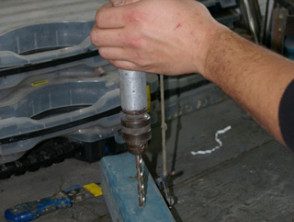Introduction
occupational hand dermatitis In motor vehicle repair, workers are common. Workers in the motor vehicle repair industry may suffer from:
- Irritating hand dermatitis
- Allergic contact dermatitis
- Hand and nail infections
-
White finger vibration (hand-arm vibration syndrome, Raynaud's phenomenon)
- Acneform rashes
- Skin Cancer
- Leukoderma (White skin).
Why do motor vehicle repair workers have skin problems?
Occupational skin problems in motor vehicle repair workers are mainly caused by:
- Contact with oils, greases, solvents and degreasers.
- Sensitive or pre-existing skin atopic dermatitiseczema)
- Exposure to potentially toxic or allergenic chemical products
- Thermal burns
- Microtrauma
- Motorized Vibrating Hand Tools
- Cold working conditions
- Exposure to Ultraviolet radiation.

Mechanic

Mechanic

Mechanic
Understanding skin problems in mechanics
The outermost layer of the skin (the corneal cell layer of the epidermis) acts as a barrier to prevent infection and to prevent potential Allergens to penetrate the skin. Their pH It is slightly acidic, which can help neutralize the degreasing agents found in soaps, which are alkaline. Excessive use of soaps and some detergents can destroy the acidity and degrease the surface of the skin and, therefore, the protection it offers.
If the moisture content of the skin is too high (overhydrated skin) or too low (dry skin), the skin's barrier function may be affected. Environments with air conditioning and low humidity It will cause the skin to become dry, rough, thickened and flaky. This eventually leads to cracking of the skin due to loss of elasticity. Excessive hydration of the barrier layer from prolonged contact with water, or from sweating inside gloves also results in dry skin, as impaired barrier function allows moisture in the skin to evaporate.
How does occupational skin disease occur?
Occupational skin disease can occur in the following circumstances:
- Mechanical or chemical injuries to the skin damage the skin's defensive barrier layer, making the skin more susceptible to further mechanical or chemical injuries.
- Damage to the barrier layer increases the risk of infection and also increases the risk of developing contact. allergy, since potential allergens can gain access to immunocompetent cells in the deeper layers of the skin. Some foreign substances gain access to the skin through sweat ducts or hair follicles, avoiding the skin barrier.
Irritant contact dermatitis
Irritant contact dermatitis is the name given to inflammation of the skin as a result of direct contact with a chemical or physical agent that damages the skin. Examples of irritants include:
- A wide range of industrial chemicals used in the motor vehicle repair industry, including heavy metals contained in brake fluids, degreasers, detergents, oils and lubricants, metal cleaners, paints, liquid fuel, solvents, adhesives , antifreeze, epoxy and nickel resins.
- Sanding particles, fiberglass.
- Cold conditions and low humidity causing dry skin and chilblains
- Microtrauma (abrasions)
- Exposure to ultraviolet (solar) radiation UVR and arc welding).
The characteristics of irritant contact dermatitis are varied.
- It may be a single episode that recovers, repeated recurrent episodes, or chronic dermatitis due to repetitive injury.
- In general, the degree of damage after exposure to the irritant depends on the potency of the irritant, the duration of application, the frequency of exposure, occlusion, temperature, anatomical site and individual susceptibility.
- When there is repeated exposure, previous damage can make the skin more susceptible to damage from the next exposure. However, hardening can also occur.
- Because irritant contact dermatitis is dose-dependent, tends to be restricted to the site of primary contact, which is usually the hands. A reduction in the cumulative Exposure to irritants decreases the risk of dermatitis. Conversely, occlusion of irritating chemicals or particles by gloves, jewelry (such as wedding rings), or wristwatches can aggravate dermatitis.
- Dermatitis can be dry, scaly, and fissure; either erythematous, swollen, blistered, weeping and eroded.
- Broken skin leads to a risk of skin infection (impetigo), which presents as red, painful, swollen skin with ulcerationoozing or pustules.
Allergic contact dermatitis
Allergic contact dermatitis is a immune response (allergy) to a contact allergen, such as nickel in tool handles such as wrenches and wrenches, or epoxy hardeners found in body fillers and sealants. Only people who are allergic to a specific agent (the allergen) will show symptoms. The appearance may be exactly the same as irritant contact dermatitis and often coexists with irritant contact dermatitis. There are some specific characteristics of allergic contact dermatitis.
- The allergen may have previously been tolerated for years without causing dermatitis.
- Once sensitized, the reaction can occur with minimal exposure to the allergen.
- Dermatitis can occur not only at the primary contact site, but also at secondary sites, such as a person who is allergic to rubber gloves may have dermatitis on the hands and on the face or neck, where small amounts of allergens were transferred. accidentally.
- Dermatitis occurs within hours or days after exposure to the allergen.
- Symptoms stabilize when the skin is no longer in contact with the allergen, although this may take weeks and require treatment.
- Allergic contact dermatitis can be confirmed by patch tests
Acneform rashes
Exposure to industrial oils, greases, or cooling agents can cause oil folliculitis (inflamed hair follicles) and comedones (blackheads and whiteheads). These conditions appear in any area of the body where there is excess fat on the skin or clothing, commonly the forearms and thighs.
Hand and nail infections
Hand dermatitis, wet work and trauma causing a break in the epidermis, predispose to yeast infection, which generally presents as chronic paronychia infected by Candida albicans or as intertrigo between the fingers also called erosio interdigitalis; while bacterial infection (impetigo, boils and folliculitis are usually caused by Staphylococcus aureus and/or Streptococcus pyogenes.
Skin cancers
Skin cancer is sometimes associated with the motor vehicle repair industry.
-
Thermal burns and chemical burns in the motor vehicle repair industry can be caused by contact with hot surfaces, e.g. exhaust pipes or hot melt chemicals, sudden release from hot water and steam lines, radiator piping and cooling systems, welding and brazing operations. Scarring will occur if the dermal layer of skin is affected. In some cases, and mostly associated with chronic burns, evil one changes in the shape of a Marjolin ulcer (a very aggressive scaly cell carcinoma) are known to occur in areas of previously traumatized skin, with chronic inflammation or scarring. Basal cell carcinomas can also appear in scars such as welding burn scars.
- Repeated exposure to waste motor oils and petroleum-based chemicals (gasoline and diesel) can cause skin cancer
- Arc welding operations cause exposure to UV rays, which can also cause skin cancer.
Leukoderma
Contact leukoderma (sometimes spelled leucoderma), or white skin, occurs when the melanocytes (the pigment-producers) are selectively destroyed. Although it may resemble vitiligo, leukoderma is due to toxic effects on melanocytes, while vitiligo is a autoimmune process. Leukoderma can follow skin contact with chemicals such as phenol, and phenolic resins can be found in brake pads, brake shoes and clutch discs.
White finger vibration
White finger vibration, also known as hand-arm vibration syndrome, is one of the causes of Raynaud's phenomenon. White finger vibration is caused by repetitive injuries caused by vibrating hand tools such as sanders, polishers, and air chisels. The duration of exposure before symptoms develop varies from months to years, and the risk of symptoms increases with the intensity and duration of exposure. If vibration exposure is not reduced early in the disease, permanent damage may result. Specific features and symptoms of white finger vibration include:
Specific features and symptoms of white finger vibration include:
- Tingling and numbness in the fingers.
- Reduced grip strength
- Fingers turn white (whiten) when it is cold, and red and painful when overheated.
Occupational risk assessment
Workplace risk assessments identify “hazards” (anything that has the potential to cause harm) and “risk” (the likelihood of an event occurring). The goal should be to reduce them, as sickness absence from work can be prolonged and costly. Poor health can negatively affect quality of life; the ability to work in a chosen industry; insurance costs and litigation claims. A generic risk assessment at any motor vehicle repair facility should include a specific section on skin exposure and should cover:
- Hazardous properties and adverse health effects of exposure to chemicals.
- Dangerous properties of vibrating tools.
- Frequency and duration of exposure.
- Controls and their effectiveness.
-
Personal protection equipment.
Staff education and training should include:
- Familiarity with material safety data sheets for chemicals used in the workplace
- Information on the safe use and maintenance of tools used in the workplace.
- Skin care education
- Reporting accidents / incidents / occupational health problems
- Correct use and maintenance of personal protective equipment.
The results of workplace risk assessments must be recorded and maintained.
Health surveillance
Health surveillance should be carried out when workplace risk is minimized rather than eliminated. Staff should be encouraged to report any signs of skin problems and all reasonable steps should be taken to resolve the problem and prevent recurrences. This may involve a referral for medical advice.
Good general advice for motor vehicle repair workers.
- Substitute less hazardous chemicals where possible.
- Ensure adequate ventilation for air toxins and potential allergens such as epoxy and isocyanate chemicals, and sanding and grinding particles.
- Vibrating tools must be in good working order and suitable for the job. Choose low vibration brands/models where applicable. Use anti-vibration gloves as appropriate. Take breaks.
- Wear personal protective equipment such as gloves, masks, eye protection, respirators, and coveralls as appropriate for the job.
Good Hand Care Tips for Automotive Repair Workers
- Use personal protective equipment according to the manufacturer's instructions.
- Remove contaminants from your skin by washing with clean, warm water before eating, drinking, smoking, or using the bathroom.
- Use the mildest cleaner required to do the job. Never wash your hands with concentrated cleaning products, solvents or fuel.
- Barrier creams used before work may be appropriate in some circumstances, to facilitate skin cleansing.
- Use moisturizers after work and after washing your hands.
- Change dirty overalls regularly.
- Never keep oily rags in your pockets.
- Report skin problems to management.
Treatment of professional skin diseases.
Management of hand dermatitis in a motor vehicle repair worker may include the following:
- Take a complete history of the work performed to identify possible causes of the dermatitis.
- Minimize contact with irritants (e.g., solvents, dust, water)
- Avoid known allergens
- Optimizing the skin's barrier function with adequate emollients, barrier creams and moisturizers frequently applied during work and at home
- Applying powerful current corticosteroid flares for dermatitis
- Antibiotic prescription for secondary bacterial infection.

